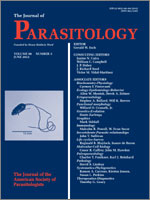To determine the relationship between the species richness, diversity of helminth communities, and migration distance during upward migration from coast to freshwater, helminth communities in the anadromous fish Coilia nasus were investigated along the coast of the East China Sea, the Yangtze Estuary, and 3 localities on the Yangtze River. Six helminth species were found in 224 C. nasus. Changes in salinity usually reduced the survival time of parasites, and thus the number of helminth species and their abundance. Except for the 2 dominant helminths, the acanthocephalan Acanthosentis cheni and the nematode Contracaecum sp., mean abundance of other 4 species of helminths was rather low (<1.0) during the upward migration in the Yangtze River. Mean abundance of the 2 dominant helminths peaked in the Yangtze Estuary and showed no obvious decrease among the 3 localities on the Yangtze River. Mean species richness, Brillouin's index, and Shannon index were also highest in the estuary (1.93 ± 0.88, 0.28 ± 0.25, and 0.37 ± 0.34, respectively) and did not exhibit marked decline at the 3 localities on the Yangtze River. A significant negative correlation was not seen between the similarity and the geographical distance (R = −0.5104, P = 0.1317). The strong salinity tolerance of intestinal helminths, relatively brief stay in the Yangtze River, and large amount of feeding on small fish and shrimp when commencing spawning migration perhaps were responsible for the results.
How to translate text using browser tools
1 June 2012
Richness and Diversity of Helminth Communities In the Japanese Grenadier Anchovy, Coilia nasus, During Its Anadromous Migration In the Yangtze River, China
Wen X. Li,
Hong Zou,
Shan G. Wu,
Rui Song,
Gui T. Wang
ACCESS THE FULL ARTICLE

Journal of Parasitology
Vol. 98 • No. 3
June 2012
Vol. 98 • No. 3
June 2012




